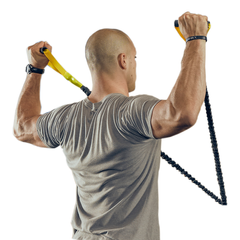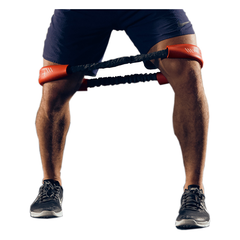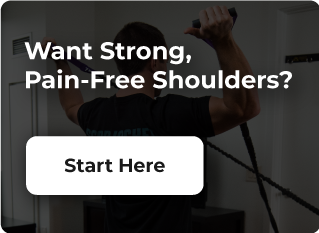The most frustrating part of frozen shoulder isn’t just the pain—it’s the timeline that can stretch on for months or even years, with little way of knowing the prognosis.
That uncertainty is where having a plan matters.
An exercise system like Crossover Symmetry can play an important role in recovery, but frozen shoulder is more complex than simply “do these exercises, and you’ll be fine.”
Let’s break down what frozen shoulder actually is, what the research supports, and how to manage it intelligently at each stage.
What is Frozen Shoulder?
Frozen shoulder, also known as adhesive capsulitis, is caused by inflammation and thickening of the connective tissue that surrounds the shoulder joint. The underlying causes remain uncertain and even sometimes appear out of the blue.
That said, frozen shoulder is more common in:
-
People with diabetes
-
Individuals who’ve had prolonged shoulder immobilization (often after injury or surgery)
-
Women, particularly during peri-menopause and menopause
There’s also growing evidence suggesting low-grade systemic inflammation may play a role (ref).
Here is a rough timeline of frozen shoulder, which is broken into 3 phases: freezing, frozen, and thawing.
- Freezing (2-7 months) – During this stage, the shoulder is typically painful at end ranges of shoulder movement in all directions and often very painful at night.
- Frozen (4-12 months) – At this time, stiffness primarily limits the shoulder. There may still be some pain but it’s less than experienced during the freezing stage.
- Thawing (5-24 months) – The thawing stage is the light at the end of the tunnel, albeit it may be a long tunnel. There’s typically minimal pain and a progressive improvement in range of motion.
Depending on where you’re at in the process you’ll have different directives for treatment.
Getting Past Frozen Shoulder
The good news is that 90% of people with frozen shoulder will recover with conservative management strategies like exercise and stretching (ref). However, it can be a long and frustrating road, especially for the active individual.
Here we’ll highlight the current best practices in dealing with frozen shoulder and help identify the best strategies for getting past it, and more specifically how Crossover Symmetry can support this plan.
During the Freezing Stage
In the early stage of frozen shoulder, the primary issue is pain.
NSAIDs and other oral steroids can be somewhat useful during this initial “freezing” stage. They don’t provide a significant change in the overall recovery or duration of symptoms but do offer moderate pain relief. It’s worth noting that long-term use of NSAIDs and oral steroids is linked to stomach ulcers, weight gain, and has adverse effects on the liver and kidneys.
Another option shown to be more effective in the early stages of freezing is corticosteroid injections. During this early stage, a cocktail of corticosteroids alongside a high-volume dose of saline and localized anesthetics offers promising results. Other than a slight risk of infection, the side effects are few, and it has better long-term pain reduction.
During this time, aggressive stretching is counterproductive, but gentle, light exercise within your pain-free range is beneficial. An exercise program like Crossover Symmetry is recommended, but stick with exercises that you can perform with little pain and without having to compensate too much to achieve an adequate range of motion.
The best Crossover Symmetry options are usually:
- Row
- Pull-down
- Reverse fly (with a modified range)
- Scaption (just to shoulder height or pain limitation)
During the Frozen and Thawing Stages
Unfortunately, despite one’s best efforts during the freezing phase, most will spend some amount of time in the “frozen stage.” During this time, pain usually decreases, but the shoulder remains stiff, and the range of motion is limited. Because pain becomes less of an issue, injections and other pain relief agents are not as effective.
Instead, the focus transitions to more aggressive stretching and physical therapy.
Eventually, stiffness will decrease, and individuals will note improved range of motion and only slight pain. These changes mark a progression to the “thawing” phase. Strategies encouraged during this stage include more aggressive stretching, physical therapy, aerobic exercise, and basic strength training.
So keep up with Crossover Symmetry as your range of motions allows, even trying the Strength program as mobility improves. This will help to limit the limitations caused by frozen shoulder and improve strength as you work through the issue.
When Conservative Care Isn’t Enough
Despite injections, physical therapy, and pain medications, some will need more advanced treatment. If pain and limited range of motion persist for more than 6-9 months, more advanced medical procedures may be indicated.
These are invasive protocols that aggressively attack the contracted shoulder tissue using anesthesia to sedate the patient and then manipulating the shoulder, or more popular these days, is arthroscopically cutting the capsule.
These more advanced methods do show good results, but create lasting changes to the shoulder structure. Therefore, these options are a last-ditch approach to treating the condition, especially for one who hopes to return to more strenuous activity.
Crossover Symmetry for Frozen Shoulder
Unfortunately, there’s no slam dunk for a frozen shoulder.
There is a lot that remains unknown, paired with the fact that each episode is unique, so what works for one may not help the other. Although what we do know is that movement is an important part of the recovery process for any ailment.
Specifically for frozen shoulder, here is a quick take-home summary of a plan to help you get past the issue using your Crossover Symmetry System.
Frozen shoulder has 3 stages:
- Freezing – The primary issue is pain with some restrictions in range of motion. Corticosteroid injections and high-volume injections may be useful during this stage. This is not the time for aggressive stretching or strength training, but some light use of Crossover Symmetry exercises is beneficial for reducing the pain and limitations.
- Frozen – Some pain may still be present but a loss in a range of motion is the primary limiter. More aggressive stretching and a shoulder strength program like Crossover Symmetry (but with modifications for the limited range of motion) are important during this stage.
- Thawing – In the final stage, the shoulder range of motion progressively improves and pain is usually minimal. Keep up with aggressive stretching and you can progress your resistance training within your available range of motion.
Read on about how Crossover Symmetry can fit into your treatment plan with The Approach to Shoulder Pain
 Shoulder Packages
Shoulder Packages
 Hip & Core Package
Hip & Core Package
 NEW - Crossover TORQ
NEW - Crossover TORQ
 Bundles
Bundles
 Accessories
Accessories
























